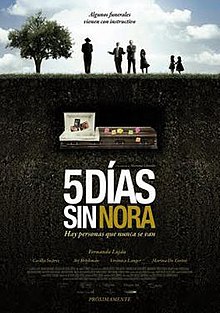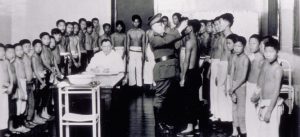
La Tía Leah en Nora’s Will
Directed by Mariana Chenillo, Nora’s Will surrounds the death of Nora Kurtz who, prior to her suicide, invites several guests to a Passover dinner. Each person invited was involved someway in her life. Jose Kurtz, her ex-husband, finds Nora after she overdosed on pills and proceeds to revisit his own past with her and investigate the curious events that led up to her death. The plot follows a number of characters, but primarily Jose, who learns that while he and Nora were married there was another lover in the picture which pushes us through the rest of the film.
Chenillo does an excellent job of providing a central point for the story; the suicide of Nora and the struggle her friends, family, and the local Jewish religious leaders go through as they prepare for her burial. I found that the premise in the movie is fantastic in that there are many elements that the audience can relate to. Themes surrounding death, family and faith are all key aspects of this film. Although I would have liked to learn exactly what intent Nora has for Jose, the open ending might be interpreted in a way that we ourselves don’t always have closure with regards to death. The finality of death can make one uneasy and unsettled among many other emotions. Nora’s will for Jose allows the audience to immerse themselves into his life and it either gives us consolation and satisfaction, or it makes us reflect about what a loved one in our own life would write to us. I did not really find many weaknesses in the film aside from the casting selection. The representation of darker skinned Fabiana, a handmaiden for the Kurtz family, as a subserviant and Christian woman seems to fall into the stereotype that is constantly perpetuated in the film industry, but aside from that I have no major critiques. I enjoyed the sprinkles of wit, humor and irony with the various Jewish faith references as it alleviated the emotions that surrounded Nora’s death.
This film is excellent in that it plays into the themes that we are currently undertaking in our “Race in Latin America” course. Although this is a film that can be understood to have taken place within the past 15 years, there is a connection that resonates with just about any person within any given time period; the changes that occur throughout life and the relationships that make up a person, and what is left after death. The rituals, customs and culture are brought out constantly throughout this film and relate to how groups of people come together from all walks of life surrounding major life events. We have to be mindful about others cultural and religious practices when different traditions cost. A perfect example of this dynamic can be seen with Moises and Fabiana. Initially there were tensions amongst the two as Fabiana, a devout Christian, and Moises, a Jewish convert and Shomer, engage with each other. Moises would later share that he grew up near the same town that Fabiana was from. This changes the relationship between the two, and they find that they have many more similarities than they initially thought.
Our course seeks to find the ways into which we perceive “the other.” The ideas that keep two groups of people apart can purely subjective and ideological in nature. Once we begin to look into the character of other groups, faiths, and cultures, we can then more astutely make suggestions as to how we associate. Was this Nora’s will or intention in the end? That is, to bring groups of people who apparently don’t belong… together, to share a meal? We may never know…



